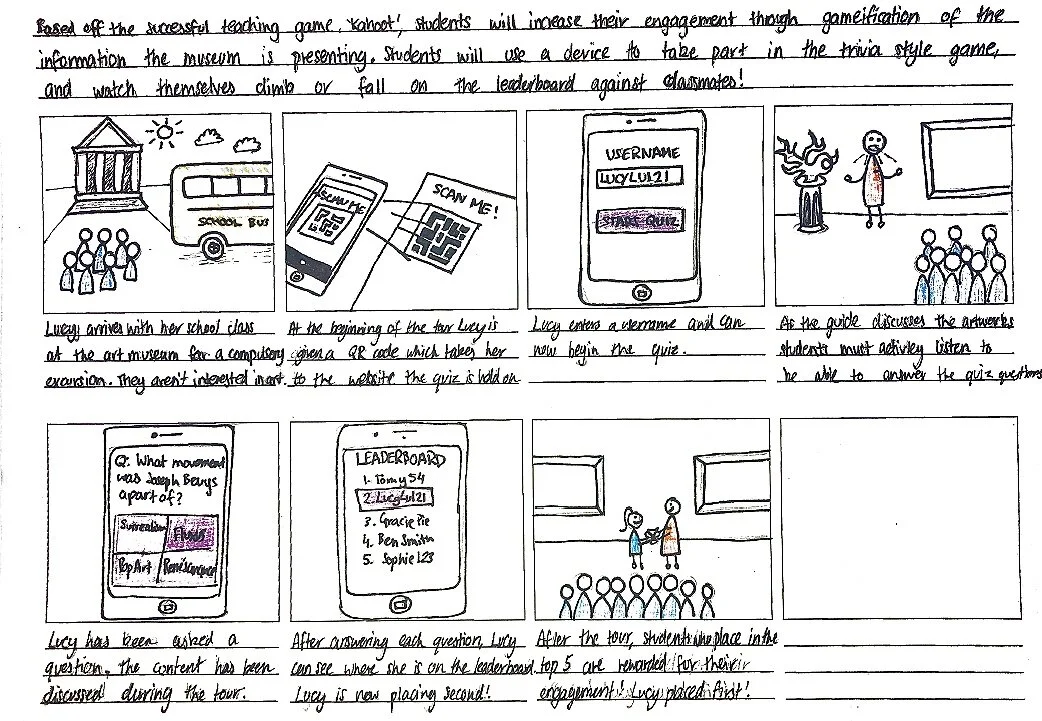
Useum:
June, 2019
Our vision with Useum was to heighten the involvement and interaction of students on school day-tips to the Art Gallery of New South Wales. We achieved this through investigating emergency technologies and utilising them to enhance students experience inside the museum.
Primary Research
The research objective was to map the process of user experience in museums and to discover what factors impact the experience. The research questions consisted of:
What are the major events that a student experiences within the museum and how they effect their experience?
How do the users interact with these events? What moments increase/decrease their overall experience?
What techniques do museum curators use to interact with the user?
What are the most valuable factors when considering a students experience inside a museum?
What is the opportunity space for museums?
The research methods utilised included, context-mapping sessions to gain a deeper understanding of our users. To ensure we utilised this method effectively, we designed probe kits. These include, a sensitising booklet, an icebreaker, a cognitive map and a collage. Through the combination of these techniques, an in depth understanding of the experience students have in museums.
Our findings where summarised in the infographic below:
Concepts
Through the research, it became evident that the successful integration of technology with exhibitions will not only provide further engagement but provide a deeper level of contextual understanding and thinking.
Both concepts utilise the application of mobile devices as secondary research provided evidence that over 95% of Australian students own or have access to a smart phone.
Augmented Reality App
The inspiration for the concept stems from the AR app Pokemon Go. The app was extremely successful and popular within students. Business of Apps (2019) recorded that “during this early peak global players reached 45 million […] and 60% of Pokemon Go users are ages between 18 to 35, with a further 32% ages 18 and younger.”
The concept consists of an app that utilises the devices camera to allow 3D life-like characters (i.e. woolie-mamoth or Picasso) to appear in an augmented reality through the devices screen. The concept had potential to be iterated further for these characters to become tour-guides, lead students to their location in the museum, and provide students with information about themselves and what is on display in the museum.
Trivia Game App
Inspired from the game-based learning platform Kahoot, I elaborated the idea and applied it to develop the trivia game app concept. The storyboard on the right explains the app visually. The concept consists of students arriving to the museum and downloading the ‘Trivia Game App’. They create a username and select a ‘tour group’. Throughout the tour with a museum representative students will be quizzed on information the guide is teaching them. After each set of questions students are able to view themselves on a leaderboard. They will climb or fall on the leaderboard based on how fast they answer a question and if they are correct or incorrect.
The application of gamification takes students from passive learning to an engaged state. Furthermore, the added incentive of watching yourself and your school friends climb the leaderboard encourages students to further apply and engage themselves.
Decision Matrix
In order to complete this project successfully two concepts where explored to answer our design brief of how to improve the engagement of students at the Art Gallery of New South Wales (AGNSW) through the use of technology. Through our decision matrix, these ideas were explored and refined to uncover the ideal design concept.
The method utilised to refine our ideas was the Harris Method. This provided a graphical representation of the strengths and weaknesses of our design concepts. The visual representation provides a quick overview of the positive and negative score of each concept when compared against a specific criteria.
Displayed within the Harris Method is the criteria of user engagement, safety and environment and environment engagement were highlighted as our most important criteria’s to fulfil.
Design Refinement Process
Richard M. Ryan and Edward L. Deci’s paper, Intrinsic and Extrinsic Motivations: Classic Definitions and New Directions, discuss’ now motivation “is hardly an unitary phenomenon. People have not only different amounts but also different kinds of motivation.” They further expand how the self-determination theory separates motivation into categories, the category of focus for this project is the intrinsic motivation, which refers to doing something because it is inherently interesting or enjoyable. This is of importance as “intrinsic motivation results in high-quality learning”.
We aim our design to capture the intrinsic motivation of students in a museum through the combination of a physical educator and digital gamification. To ensure the device does not distract from the guides presentation, students are unable to answer questions as the information is being presented, preventing them from being distracted. When the guide has finalised their explanation students will then be tested on the information that was just presented.
Through the use of primary research, secondary sources and a decision matrix, we developed a final concept that responds to the brief. We can confidently assure that the design will heighten the involvement of students interaction in museums in order to enhance their overall user experience through active engagement and increased motivation.
User Journey Map
User Journey
This film outlines how the app would be used by students




